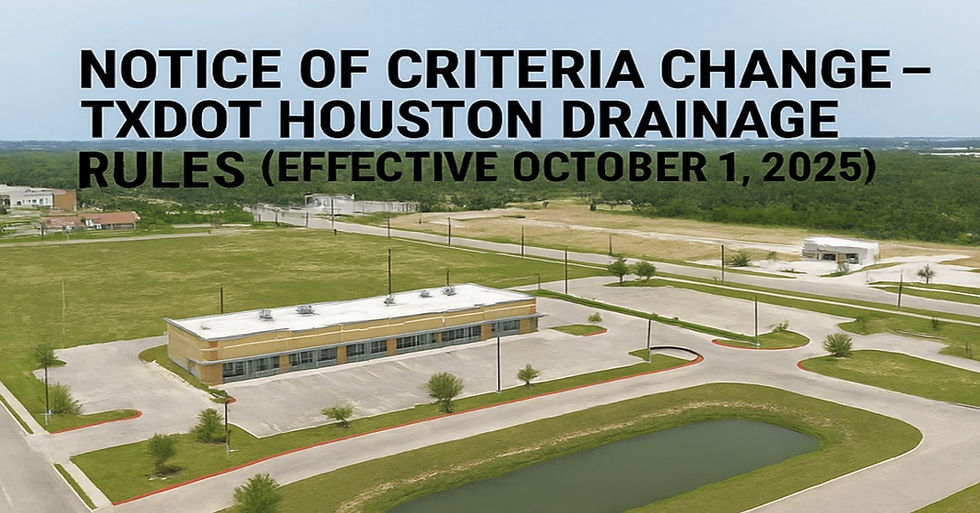Avoid Costly Surprises: How TxDOT’s New Drainage Criteria Impact Commercial Site Feasibility
- JRH Engineering & Environmental Services, Inc.
- Oct 2
- 2 min read

Attention Commercial Real Estate Professionals
The Texas Department of Transportation (TXDOT) Houston District has announced significant updates to its drainage and detention requirements, effective October 1, 2025. These changes directly affect all commercial sites.
This post focuses on the several critical points commercial real estate developers should be aware of when selecting a site.
Key Updates to Know:
Detention Rates for Small Sites
For sites under 2 acres, detention volume is now calculated at 0.85 acre-feet per acre of disturbed area - not impervious cover alone. This means even activities like removing existing paving for landscaping requirements will be counted in the
detention volume.
Definition of Existing Development
After years of industry feedback, TXDOT has finally clarified what qualifies as existing development.
o Grandfathered: Any impervious cover built prior to 2001 is considered existing, even if permit records are unavailable. Detention will apply for any redevelopment disturbed areas.
o Post-2001: If a commercial property owner cannot provide records for developments built after 2001, the site must be treated as undeveloped, which can substantially increase detention requirements.
Design Challenges for Redeveloped Sites
Projects modifying existing sites (while keeping the original building) present some of the most difficult detention scenarios:
o Detention design is bound by the building’s finished floor elevation, which limits how high the 100-year water surface elevation can be raised.
o Flat sites draining to ditches often require pumped storm sewer systems, but many cities prohibit pumps—forcing costly fill, retaining walls, or making redevelopment infeasible in FEMA floodplains.
o Sites draining to storm sewers generally allow more flexibility, but the biggest challenge remains: can a detention pond physically fit on a site under 2 acres with expansion plans?
Detention Rates for 2-5 Acre Sites
For sites under that are 2-5 acres, detention volume is till the same process which involves a series of calculations to determine required volume. Developments built after 2001 still have to show evidence of a TXDOT permit, or the development cannot be counted in the existing conditions calculations. This will increase the detention rate. We caution when purchasing an existing development track that the new buyer request for existing TXDOT approved plans. We have seen many developments fall into this category where a city permitted the project, but TXDOT did not permit the project. In these cases, the pond was under designed.
Detention Rates for 10 Acre Sites
For sites greater than 10 acres the process can be similar as the 2–5-acre requirements, but a meeting with TXDOT is required
prior to any design.
JRH’s Recommendation
These changes are tract-size driven and pose serious risks if not evaluated early. At JRH Engineering & Environmental Services, we strongly advise storm and drainage feasibility studies before committing to major land acquisitions or redevelopment plans.
Bottom line: Do not let the new criteria catch you off guard. The October 1, 2025, rule changes bring both opportunities and risks, and proper due diligence is now more important than ever.
Contact our team at JRH Engineering & Environmental Services to discuss how these updates may impact your project.










Comments